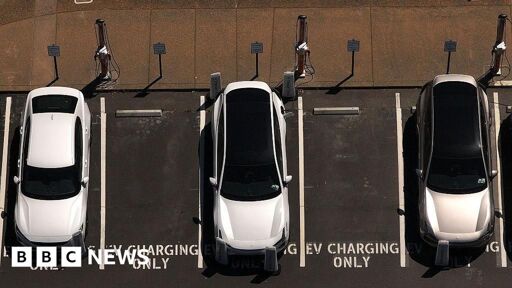They didn’t get left behind. They kicked and screamed in denial the whole time. The US government and the US car manufacturers put themselves into this position.
I just wish that factory workers wouldn’t be so impacted by the failures of the executives who wanted to make their own money by milking reputations and product lines without investing in the future. Like, if Stellantis had to shut down, it would be well deserved, but it would suck for the normal people at the bottom.
When the company wins, the executives win. When the company loses, the workers lose.
You could replace “electric car” in the title with education, telecommunications, internet, etc. and it’d also still be true.
Stubbornness and proactive regression and denialism and rejectionism and asshole privilege are a hell of a drug cocktail.
They didn’t get “left behind”, they intentionally denied reality.
From my uninformed perspective, it kind of seems like the ruling class in America said, “Oh, we can make a lot of money and improve the environment and lives of all of our people?” and said, “No. We’ve got to sell oil.”
The Biden administration actually tried to do that, but the American people rather wanted to poison the planet by turning their county into a petro dictatorship.
You mean the oligarchies that have destroyed fair elections.
That sucks. Having a two party system will eventually lead to this though.
Yeah it was the opposite of the ruling class, it was the fuck knuckles all over America
The Republican party and their allies are certainly part of the ruling class and are also fuck knuckles all over America.
You’re only improving the local environment in the sense that local emissions are lowered. However, You’re just outsourcing the pollution to Third World countries that are doing the mining, refining, etc., without any human right protections, labor, protections, pollution protections, etc.
And you have the benefit of overreaching government regulations and justifying the enshitification of existing ICE cars.
So that consumer sees the following:
-
I can buy a new car that’s more expensive and shittier more difficult and expensive to maintain.
-
Or I can buy a shittier electric version of the car with lower range, higher electric cost, a battery that won’t work in 10 years, no privacy, while degrading the roads and tires faster due to the extra weight.
Tell me how this is a surprising outcome that nobody wants to buy electric cars to save the planet? You get a shittier product you pay more for it and it’s more limiting.
Counterpoint:
Norway on track to be first to go all-electric
Norway is a much smaller country and has been preparing for this for decades. It has a much higher renewable electricity footprint, and provides numerous incentives to consumers to buy electric cars. It also seems that the government isn’t trying to constantly monitor and control their population.
When you look at the average distances, subpar charging network, and how much renewable electricity is sourced in the US, you realize that it just doesn’t work for that model.
A lot of electric vehicles just aren’t viable in the rural parts of America. Most electricity comes from petroleum and certainly not renewables.
And the added competition for AI data centers on electrical grids are also going to decentivise people from buying electric cars and paying higher energy prices to charge their car.
The US economy is essentially built on convenience and charging an electric car for hours at a time or overnight is hardly convenient. There is no way that you can make a road trip, as common in the US, without recharging the car along the way and being forced to wait.
charging an electric car for hours
How I know you don’t have an EV :P
EV’s aren’t petrol cars so you don’t run them down to 1% battery life and then charge them up from 1% to 100%
Modern EV’s charge fairly quickly:
10% to 80% charge in approx. 18 min
https://www.hyundai.com/au/en/cars/eco/ioniq5
Maybe you plug in at 40% so that’s a 10 minute charge.
We’re also seeing more and more EV chargers in shopping centre car parks, so in a few places you can park, plug in, do your shopping, and come out to a car full of beans.
And the added competition for AI data centers on electrical grids are also going to decentivise people from buying electric cars and paying higher energy prices to charge their car.
Isn’t this a greater incentive for solar? Do you not get paid for exporting power to the grid?
As far as I know, there are no incentives for people to add solar to the grid. In fact, many power companies are making it more difficult for people to do exactly that.
And yes, I understand. My argument is very basic and outdated and I don’t own an EV. I have no idea what the actual charge are for modern cars.
I will tell you that even 20 minutes for an American is unacceptable. The availability of fast chargers in the US is also pretty bad. I understand it’s been getting better, but it really varies what states you live in and they build out their local infrastructure.
Here’s what it actually takes to charge car in the US and popular 2025 models noticed that none of them are 10 to 80% percent in 40 minutes. Considering the most charging infrastructure in the US is level one a.k.a. slow charge. There’s no way you’re getting a fast charge if it’s not available in your area or too expensive.
Level 2 charging operates at a higher rate than Level 1. In residential applications, this type of charging requires a 240-volt outlet
With this type of charging, you can charge an electric vehicle to 80% from empty in 4-10 hours. With a PHEV, Level 2 charging can take up to 2 hours.
No where near 20- 40 minutes.
Avg Charge time in US: https://cars.usnews.com/cars-trucks/advice/ev-charging-time
You’re close but slightly off

Level 1 and 2 charging is for your home, there’s level 1 granny charger which is basically a regular power point into an adapter (like a laptop charger) which gets around 2.2kw, level 2 requires a level 2 charger to be installed in your house (usually in the garage or driveway) which takes the charging speed up to 7kW (single-phase) and 22kW (three-phase) but I believe most American homes are single phase.
Then you go into proper EV fast chargers (level 3) that are outside:

https://en.wikipedia.org/wiki/Tesla_Supercharger
This is where you get your <20 minute charges
If you’re charging at home generally it’s overnight while you’re asleep or during the day from solar when you don’t need to drive (like on the weekend) or if you do need to drive you take it out and come back and plug it in so there’s no real issue there.
Here is a map of how many level three fast chargers are available in each US state.

Let’s use Texas as an example here. There are 243 fast chargers in an area of 695,662km2. That’s 1 charger for every 2862 km2. Not great coverage.
That’s not nearly so helpful so let’s take a look at the distribution with each state:

You can see that most of these EV stations are located around larger metropolitan areas. If you live outside of those areas, electric cars are not really, very useful. That graphic, even though this is from 2022 that the metric is there a three times more gas stations, per capita than there are chargers.
Here is just Teslas Supercharger network. Noticed that it’s much smaller and only really works for Teslas.

Here is the map showing which of these locations allow for non-Tesla partners electric vehicle charging. There are less sites that I allow you to charge a non-Tesla vehicle.

And here is the map for others that are not partners and not part of Tesla supercharger network. There are even fewer sites that allow other cars to use the supercharger network.

So all of this is great if you own a Tesla, but if you don’t, there’s competing standards and EV Charging stations may not be compatible with your car.
deleted by creator
Typical US, taking the lazy way out.
Well, it’s just a little more challenging when your country is also half of a fucking continent. What works for one small geopolitical area cannot necessarily be applied to the rest of the continent.
Especially when the country is essentially made up of 50 smaller countries that all want different things and have different demographics and climates and environments.
And yes, Americans typically take the more convenient option and the whole focus of their fucking culture in recent history. American culture has essentially become if you can afford it you get more convenience. Just a different culture than what is in Europe and the rest of the world.
Really? China seems to be doing it.
They have one government setting the policy instead of 2 parties in 50 smaller local governments fighting with each other.
So yeah, it’s a little easier for top-down decisions on policy.
When you look at the average distances, subpar charging network, and how much renewable electricity is sourced in the US, you realize that it just doesn’t work for that model.
Ok, let’s rework this to be an argument from the 2000’s:
When you look at the average distances, subpar telecom network, and how much technology is sourced from China, you realize that broadband just doesn’t work for that model.
But, yet, here we are in 2025 with somewhat passable broadband in many (but NOT all) areas.
-
Because of their arrogance, and the fact that most of the executives are old and know that it doesn’t matter what happens now, they’ll die disgustingly rich








